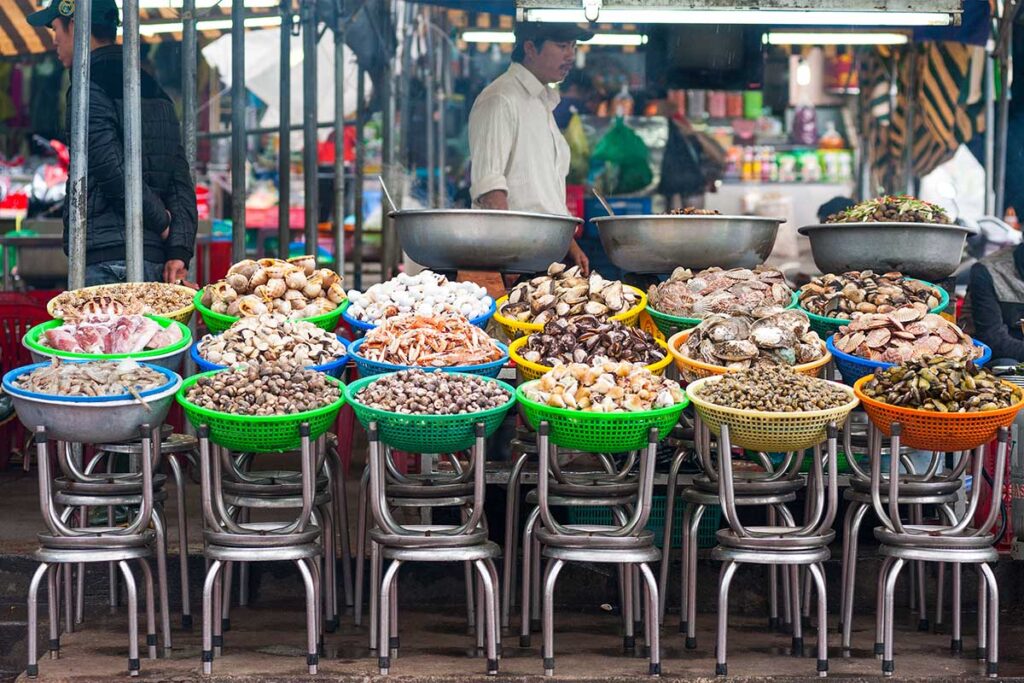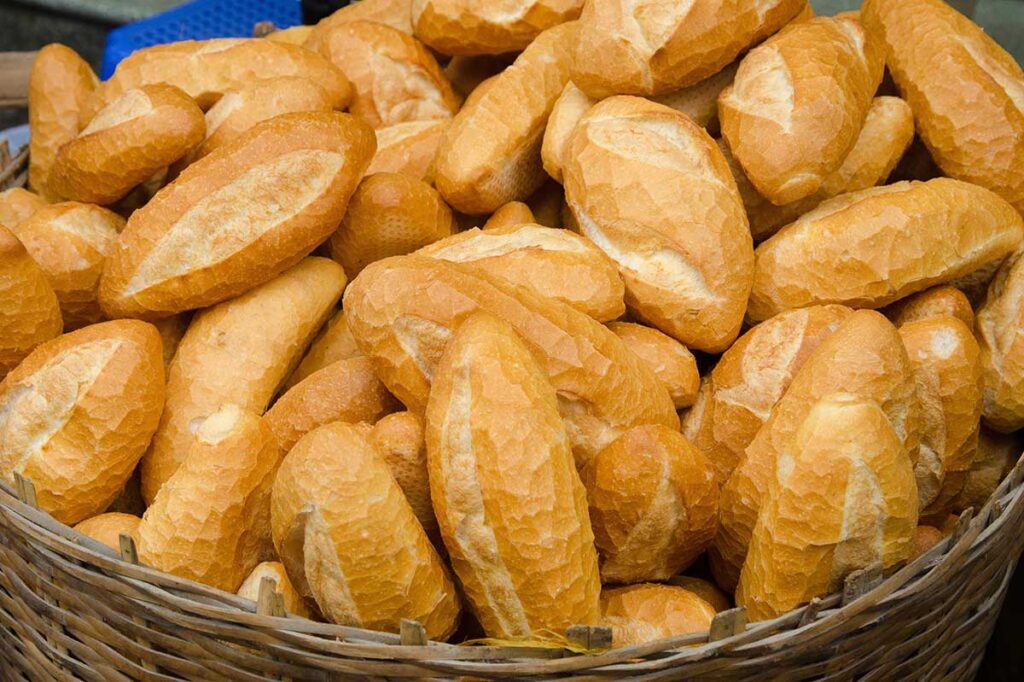Food allergies can present challenges when traveling to a new country, but with careful planning and preparation, you can still enjoy the diverse flavors of Vietnam. Common food allergies include peanuts, shellfish, gluten, and dairy. This guide will provide you with essential information and tips for managing your allergies while exploring Vietnam’s culinary landscape.
- General tips
- Peanut allergy
- Shellfish allergy
- Gluten allergy
- Dairy allergies
- Fish allergy
- Soy allergy
General tips for traveling with food allergies in Vietnam
1. Write your allergies in Vietnamese
It’s crucial to communicate your allergies clearly. Write down your allergies in Vietnamese and keep the note with you at all times. For example, “Tôi bị dị ứng với đậu phộng” means “I am allergic to peanuts.”
2. Request it when you book a tour or experience
When booking tours or experiences, inform the operators about your food allergies in advance. This allows them to make necessary arrangements and ensure your safety.
3. Research common Vietnamese dishes
Understand which common Vietnamese dishes use ingredients you are allergic to. This will help you avoid potential allergens and make safer food choices.
4. Bring medication
Always carry your prescribed allergy medication, such as antihistamines or an epinephrine auto-injector. Ensure you have enough medication for the entire trip.
5. Learn key phrases
Learn key phrases in Vietnamese to communicate your allergies. Phrases like “Tôi bị dị ứng với…” (I am allergic to…) followed by the specific allergen can be very useful.
6. Use allergy translation cards
Consider using allergy translation cards, which you can show to restaurant staff to explain your allergies clearly and effectively.
7. Avoid street food
Street food vendors may not have the knowledge or facilities to accommodate food allergies. Opt for established restaurants where you can communicate your needs better.
8. Be cautious with sauces and condiments
Many Vietnamese dishes use various sauces and condiments that may contain allergens. Always ask about the ingredients before consuming them.
9. Pack safe snacks
Bring a supply of safe snacks from home in case you have difficulty finding suitable food options.
10. Choose restaurants carefully
Opt for restaurants that cater to tourists or have English-speaking staff. These establishments are often more familiar with food allergies and can offer safer options.
Traveling with a peanut allergy in Vietnam

Peanut allergies, while not as common in Vietnam as in Western countries, still require careful attention. Peanuts are occasionally used as a garnish or ingredient in some dishes, and cross-contamination is a possibility.
Tip: Always double-check with the restaurant staff about the presence of peanuts in any dish, even if it’s not listed on the menu.
Vietnamese dishes and sauces that may contain peanuts:
- Mì Xào: Stir-fried noodles
- Gỏi Cuốn: Spring rolls (especially those with peanut sauce)
- Bún Chả: Grilled pork with vermicelli noodles (often served with peanut sauce)
- Phở: Beef noodle soup (some variations may include peanuts)
- Some dipping sauces: Hoisin sauce, peanut sauce
Important Note: Even if a dish doesn’t contain peanuts, there’s a risk of cross-contamination in kitchens that handle peanuts. Always inform the restaurant staff of your allergy and ask them to take precautions.
Traveling with a shellfish allergy in Vietnam

Shellfish allergies are relatively common and require extra vigilance in Vietnam, as seafood is a staple in Vietnamese cuisine.
Tip: Be extra cautious when dining in coastal areas, where seafood is more prevalent. Always ask about the ingredients in any dish, even if it doesn’t seem like it would contain shellfish.
Vietnamese dishes and sauces that often contain shellfish:
- Bún Riêu: Crab noodle soup
- Mắm Tôm: Shrimp paste
- Hải Sản: General term for seafood dishes
- Nước Mắm: Fish sauce (some variations may include shellfish)
Important Note: Be aware that some dishes may contain hidden shellfish ingredients, such as shrimp paste used as a flavoring. Always ask the restaurant staff to confirm the ingredients before ordering.
Traveling with a gluten allergy in Vietnam

Gluten allergies, while less common in Vietnam than in Western countries, can still be managed with proper precautions. Rice is a staple in Vietnamese cuisine, offering plenty of gluten-free options.
Tip: Look for dishes made with rice noodles (bún) or rice paper (bánh tráng) as these are naturally gluten-free.
Vietnamese dishes and sauces that may contain gluten:
- Xôi: Sticky rice (some variations may include soy sauce, which contains gluten)
- Bánh Mì: Vietnamese baguette sandwich (the bread contains gluten)
- Mì: Wheat noodles (contain gluten)
- Some dipping sauces: Soy sauce, hoisin sauce (may contain gluten)
Important Note: Be aware that some dishes may be cooked with utensils or in pans that have also been used for gluten-containing foods. Inform the restaurant staff of your allergy and ask them to take precautions to prevent cross-contamination.
Traveling with a dairy allergies in Vietnam
Dairy allergies are less common in Vietnam, as dairy products are not as widely consumed as in Western countries. However, it’s still important to be cautious.
Tip: Be aware that some Vietnamese desserts and coffee drinks may contain condensed milk.
Vietnamese dishes and sauces that may contain dairy:
- Cà Phê Sữa: Vietnamese coffee with condensed milk
- Bánh Flan: Vietnamese crème caramel
- Sữa Chua: Yogurt (often made with cow’s milk)
Important Note: While dairy allergies are less prevalent in Vietnam, it’s still essential to inform restaurant staff of your allergy to avoid any potential issues.
Traveling with a fish allergy in Vietnam
Navigating Vietnamese cuisine with a fish allergy requires extra diligence due to the widespread use of fish sauce. This fermented condiment, made from anchovies and salt, adds a unique umami flavor to many dishes. Even seemingly fish-free dishes might contain fish sauce, either as a direct ingredient or as a hidden component in other sauces or marinades.
Specific Tip: When dining out, it’s crucial to inform the restaurant staff about your fish allergy and inquire about the presence of fish sauce in any dish, even if it doesn’t explicitly list fish as an ingredient. Inquire about the ingredients of any sauces or marinades used in the preparation. Be prepared to ask for alternative seasonings or request dishes that can be made without fish sauce.
Vietnamese dishes that often contain fish sauce:
- Almost all dipping sauces: Nước chấm (the ubiquitous dipping sauce) often includes fish sauce.
- Marinades for grilled meats and vegetables: Fish sauce is a common ingredient in marinades to enhance flavor.
- Stir-fries: Fish sauce might be used for seasoning in stir-fried dishes.
- Noodle soups: Some noodle soups use fish sauce as a base for the broth.
- Salads: Certain Vietnamese salads might contain fish sauce in the dressing.
Traveling with a soy allergy in Vietnam
Soy allergies, while less prevalent than some other allergies, can still pose challenges in Vietnam due to the use of soy sauce and other soy-based products in various dishes.
Specific Tip: As soy sauce is a common ingredient in Vietnamese cuisine, always inform the restaurant staff about your soy allergy and inquire about its presence in any dish, even if it’s not explicitly listed on the menu. Ask if they can prepare dishes without soy sauce or use an alternative seasoning. Be aware that fish sauce (nước mắm) is sometimes used in conjunction with soy sauce, so inquire about both.
Vietnamese dishes and sauces that may contain soy:
- Tương: A fermented soybean paste used as a condiment.
- Mì Xào: Stir-fried noodles (may contain soy sauce).
- Bún Chả: Grilled pork with vermicelli noodles (often served with soy sauce-based dipping sauce).
- Phở: Beef noodle soup (some variations may include soy sauce).
- Gỏi cuốn: Spring rolls (may contain soy sauce in the dipping sauce or filling).



